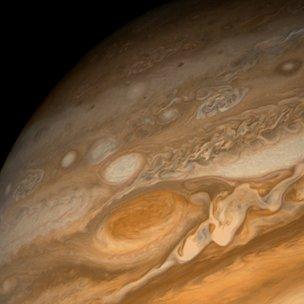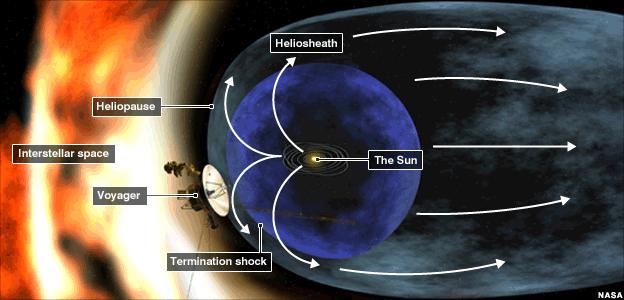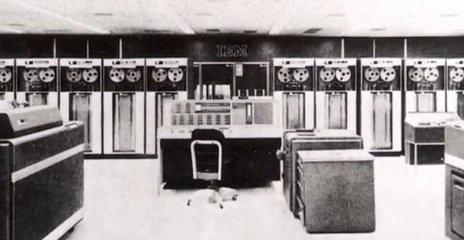The maths that made Voyager possible
- Published
In 1961, mathematics graduate Michael Minovitch decided to take on the hardest problem in celestial mechanics - the "three body problem".
Nasa's Voyager spacecraft have enthralled everyone with their exploits at the edge of the Solar System, but their launch in 1977 was only possible because of some clever maths and the persistence of a PhD student who worked out how to slingshot probes into deep space.
On the 3 October, 1942, the nose cone of an early V2 test rocket soared high above the north German coast before falling back to a crash-landing in the Baltic Sea.
For the first time in history, an object built by humans had crossed the invisible Karman line, which marks the edge of space.
Astonishingly, within 70 years - just one human lifespan - we'd hurled another spacecraft right to the edge of the Solar System.
Today, 35 years after leaving Earth, Voyager 1, external is 18.4 billion km (11.4 billion miles) from Earth and about to cross over the boundary marking the extent of the Sun's influence, where the solar wind meets interstellar space.
Sometime in the next five years, it will likely break through this so called "bowshock" and head out into the galaxy beyond. Its twin, Voyager 2, having flown past all the outer giant planets, should pass over into interstellar not long after.
It's easy to take this monumental achievement for granted, but the gateway to the outer Solar System remained shut for the first 20 years of the space age.
In 1957, as Sputnik 1 became the first engineered object to orbit our home planet, mission planners started to look towards other worlds to propel their probes.
Spacecraft were quickly dispatched to the Moon, Venus and Mars. But there was one major limiting factor to reaching more distant destinations.
For a voyage to the outer planets, you must escape the gravitational pull of the Sun, and that demands a very large rocket indeed. And given what an "uphill" gravitational struggle it would be to reach them, such a journey to the furthest planet - Neptune, more than four billion km (2.5 billion miles) away - could easily take 30 or 40 years.
At the time, Nasa couldn't guarantee a spacecraft for more than a few months of operational life, and so the outer planets were considered out of reach.
That was until a 25-year-old mathematics graduate called Michael Minovitch came along in 1961.
Excited by UCLA's new IBM 7090 computer, the fastest on Earth at the time, Minovitch decided to take on the hardest problem in celestial mechanics: the "three body problem".

The issue was being able to reach the outer planets in practical timeframe
The three bodies it refers to are the Sun, a planet and a third object such as an asteroid or comet all travelling through space with their gravities acting on each other. The problem is predicting exactly how the gravity of the Sun and the planet will influence the third object's trajectory.
Astronomers had been pondering the three-body problem for at least 300 years, ever since they'd started plotting the path that comets took as they fell through the inner Solar System towards the Sun.
Undeterred by the fact that some of the finest minds in history, including Isaac Newton hadn't solved the three-body problem, Minovitch became focused on cracking it. He intended to use the IBM 7090 computer to home in on a solution using a method of iteration.
In his spare time, whilst studying for his PhD during the summer of 1961, he set about coding a series of equations to apply to the problem.
Feeding data on planetary orbits into his model, Minovitch had made progress by the autumn, but was anxious to check his data. So in the summer of the following year during an internship at Nasa's Jet Propulsion Lab (JPL), he persuaded his boss to give him more accurate data on planetary positions to re-test his model.
To his delight, he ran the simulations again and found his solution still worked. What he had achieved made possible an extraordinary breakthrough in spacecraft propulsion.
Minovitch had shown, external that as a craft flew close to a planet orbiting the Sun, it would steal some of the planet's orbital speed, and be accelerated away from the Sun. Such acceleration, without using a single drop of rocket propellant seemed too good to be true, and Minovitch's critics were quick to try to discredit him.

The domain of the Sun's influence is called the heliosphere: The Voyagers are approaching the edge of this enormous balloon of charged particles thrown out into space by our star
Without funds for further computer time, and in a bid to persuade Nasa to embrace his discovery, he drew up by hand hundreds of theoretical mission trajectories to the outer planets. Among them was one very special flight path that would become the Voyagers' trajectory.
But in 1962 the Jet Propulsion Lab was preoccupied with supporting Project Apollo, and no-one spotted Minovitch's breakthrough.
It would take another summer intern called Gary Flandro to identify the opportunity.
A spacecraft engineer, grounded in the hard realities of spaceflight, Flandro knew that any mission to the outer planets would have to be flown as fast as possible, otherwise the craft might not last long enough to reach its destination.
So in the summer of 1965, he began to look at whether the solution to the three-body problem could be put to practical use in exploring the outer planets. He started by drawing graphs of where these planets were going to be in the coming years.
And to his surprise, the plots revealed that Jupiter, Saturn, Uranus and Neptune would all be on the same side of the Solar System in the late 1970s.
Using a solution to the three-body problem, a single mission, launching from Earth in 1977, could sling a spacecraft past all four planets within 12 years. Such an opportunity would not present itself again for another 176 years.
With further lobbying from Minovitch and high level intervention from Maxwell Hunter, who advised the president on US space policy, Nasa eventually embraced Minovitch's slingshot propulsion and Flandro's idea for a "grand tour" of the planets.

The solution came through using the most powerful computer of the day
Initially named "Mariner-Jupiter-Saturn", or MJS, funding to build two spacecraft was released in the early 1970s. The twin craft would eventually become known as the Voyagers.
To reach Neptune they would have to last for over a decade in space, operating in the darkest reaches of the Solar System billions of km from the Sun.
They would require radiation-hardened electronics to survive their encounters with the magnetosphere of Jupiter, and an artificial intelligence autonomous enough to make independent decisions when too far away from Earth for help.
Although still lacking funding to extend its mission beyond Saturn, Nasa's optimistic engineers loaded enough control propellant on board to keep the probes' dishes orientated towards the Earth for decades after passing Saturn.
They'd also built the Voyager power supply system to last until at least the year 2020. But most visionary of all, they'd included five experiments on board that were capable of analyzing space beyond the Solar System.
In 1977, as the duo launched from Earth, no-one dared imagine that they would survive long enough to make such measurements. But in 2012, they're still going strong - their pitifully weak signals just a billionth of a billionth of a billionth of a watt of power by the time they reach the Earth. New discoveries are still being made.
Today, in a darkened lecture theatre at JPL - named after the same Theodore von Karman, external whose boundary to space our machines first crossed 70 years ago - sits a model of the Voyagers.
These great machines are now carrying our spirit of exploration across a boundary the Hungarian-American engineer could only dream of - into interstellar space.
Voyager: To The Final Frontier will be broadcast on BBC Four on Wednesday 24 October, 2012. It is produced and directed by Christopher Riley and presented by Dallas Campbell.
.jpg)
The author Christopher Riley stands in front of the Voyager exhibition at JPL
- Published15 June 2012
- Published10 June 2011
- Published9 June 2011
- Published14 December 2010